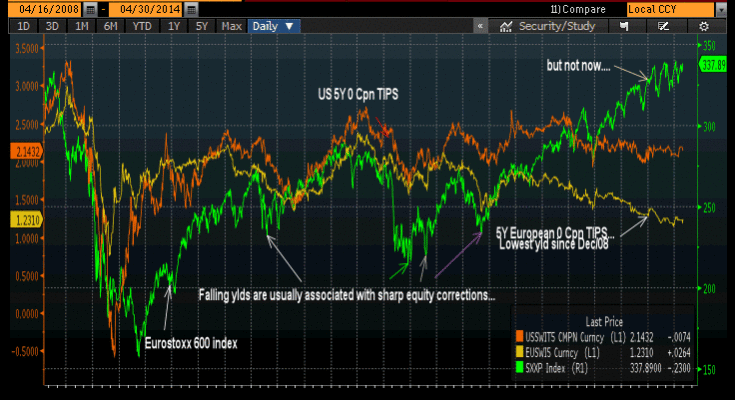More Oddities
Along the lines of the recently discussed idea that central bank interventions have distorted numerous price signals, here is some additional evidence supporting this contention. The first chart shows the Eurostoxx Index compared to inflation expectations as reflected by yields on 5 year US and euro area inflation adjusted bonds. For a long time, stock prices and yields have moved in unison. This is no longer the case. They have increasingly decoupled since late 2012/early 2013. One cannot rule out that they will converge again at some point.

Eurostoxx vs. 5 yr. US and euro area TIPs yields – click to enlarge.
Until the end of 2012, the CRB commodities index was directionally strongly correlated with US 5 year inflation breakeven rates. Since then, the two data series have become a lot less correlated. It remains to be seen if the recent surge in commodity prices will change that:

5 year US inflation breakeven rate vs. the CRB index (yellow line)Â – click to enlarge.
European banks have been massive buyers of government bonds in the debt expansion orgy of the faux ‘austerity’ era (during which public debt expanded globally from $70 to $100 trillion). Ideas voiced during the sovereign debt crisis with regard to assigning some sort of risk weighting to sovereign bonds have been quietly dropped again. The biggest buyers of sovereign debt were banks in countries like Italy and Spain, which is akin to Enron propping up Worldcom.
It is well known that European banks have done comparatively little to reduce their leverage or bolster their equity. Their situation is less precarious than before as government bond yields in the euro area have once again converged at very low levels, but has this really made the banks less risky? Keep in mind that CDS spreads on 5 year Greek government debt were at 38 basis points in 2007, only to reach more than 26,000 basis points four years later. In the process the entire Greek and Cypriot banking systems were bankrupted.

